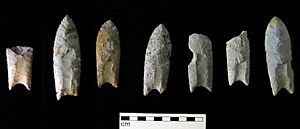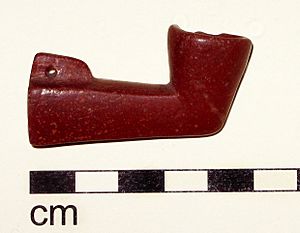Archaeology of Iowa facts for kids
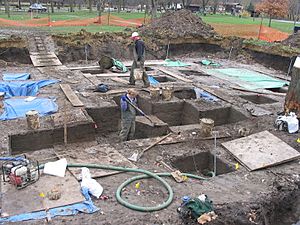
Iowa archaeology is the study of ancient human life in Iowa. Archaeologists learn about past cultures by digging up and studying things people left behind. These include tools, pottery, and even old buildings. People have lived in what is now Iowa for over 13,000 years.
The first people in Iowa were hunters and gatherers. They lived in a cold, icy landscape. Over thousands of years, they slowly changed their way of life. They began to settle down and farm. By the time European explorers arrived, Native Americans in Iowa were skilled farmers. They had complex societies and trade systems. This article explores the different periods of Iowa's rich archaeological past.
Contents
Iowa's Archaeology Story
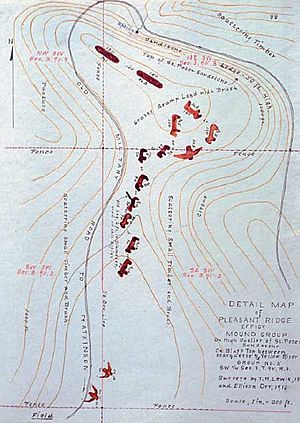
People have been studying Iowa's ancient past since the mid-1800s. Back then, large Native American mounds were first noticed along the Mississippi River. Early researchers like S.V. Proudfit and Theodore Lewis recorded many important sites. These included earthworks, mounds, and earthlodges.
Real scientific study began in the 1920s with Charles R. Keyes and Ellison Orr. They surveyed and dug at hundreds of sites. Their work helped create the Iowa Archaeological Survey and the Iowa Archeological Society. It also led to the protection of Effigy Mounds National Monument.
Today, the Office of the State Archaeologist (OSA) continues this work. It keeps a list of over 23,000 archaeological sites in Iowa. Many universities and private groups also study Iowa's past. New laws in the 1960s helped archaeology grow. These laws require archaeological surveys before many building projects.
Paleoindian Period (13,500–10,500 years ago)
The first people in Iowa were Paleoindian hunters and gatherers. They arrived as the last Ice Age was ending. Iowa was a mix of cold tundra, pine forests, and leafy forests. A huge glacier, the Des Moines Lobe, was melting in central Iowa.
These early people moved around a lot. Their sites are found across Iowa. They are known for their large, well-made stone spear points. People once thought they only hunted huge animals like mammoths. But new research shows they also ate smaller animals and wild plants.
It's hard to find intact Paleoindian sites. This is because they were temporary camps. Also, farming has destroyed many, or they are buried deep in river valleys.
Early Paleoindian: Clovis Points
The oldest tools in Iowa are Clovis points. These are large, leaf-shaped spear points. They are found almost everywhere in Iowa, except where the Des Moines glacier was. These points might have been used to hunt giant Ice Age animals. These included mammoths, mastodons, and huge bison, which are now extinct.
Only two Clovis sites have been dug up in Iowa. The Rummells-Maske site in Cedar County had 20 Clovis points. The Carlisle Clovis Cache Site in Warren County had 38 unfinished stone tools. Other early points like Gainey and Folsom points are also found in Iowa.
Late Paleoindian: Dalton Points
After the glaciers were gone, humans in Iowa used different types of spear points. These included Dalton, Fayette, Agate Basin, and Hell Gap points. People still moved around a lot. By this time, most of the giant Ice Age animals had died out. Like the earlier period, no complete Late Paleoindian sites have been found in Iowa.
Archaic Period (10,500–2,800 years ago)
The Archaic period is the longest time period in Iowa's prehistory. It lasted about 8,000 years. During this time, the number of people in Iowa grew. Native Americans slowly changed from moving hunters and gatherers to people who focused on local resources. They also began to use domesticated plants toward the end of this period.
Early Archaic (10,500–7,500 years ago)
During the Early Archaic, people in different parts of Iowa started using unique stone tools. They adapted to local hunting and gathering. They likely still moved seasonally between camps. Common tools include Corner-notched St. Charles points and Thebes Knives. Important sites include the Soldow Site and the Cherokee Sewer Site.
Middle Archaic (7,500–5,000 years ago)
Temperatures rose during the Middle Archaic, making Iowa warmer and drier. Grasslands grew, and many lakes shrank. People changed how they found food. In eastern Iowa, they focused on river resources. In western Iowa, they used more Plains resources. Sites like the Gast Spring Site and the Cherokee Sewer Site show these changes.
Late Archaic (5,000–2,800 years ago)
The climate became more like today's during the Late Archaic. More sites are found from this period, suggesting more people lived in Iowa. This period shows the first signs of mound building. It also has the first clear evidence of domesticated plants. These include squash, little barley, and marsh elder. Large, long-term settlements also appeared. The Red Ocher Culture in northeast Iowa built mounds and used copper tools. The Edgewater Park Site in Coralville is one place where early plant use was found.
Woodland Period (800 BC–1250 AD)
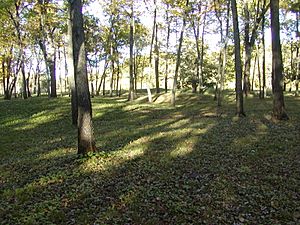
During the Woodland period, many Native Americans in Iowa started farming more. But wild foods were still important. New things became common. These included pottery, the bow and arrow, and burial mounds. There is also evidence of social leaders and groups.
Early Woodland (800 BC–200 BC)
Pottery first appeared in Iowa during the Early Woodland period. People in eastern Iowa built large burial mounds along the Mississippi River. They also traded special materials over long distances. This trade might have led to the later Havanna-Hopewell trading network. Many Early Woodland sites have been found in Iowa.
Middle Woodland (200 BC–400 AD)
Middle Woodland people in eastern Iowa were part of the Havana and Hopewell trade networks. This connection to the East is seen in their large mounds and earthworks. They also traded rare goods over very long distances. For example, obsidian from Yellowstone and copper from Lake Superior have been found. The Toolesboro Mound Group in Louisa County had a huge octagonal earthwork. This shows how far the Hopewell influence reached. Western Iowa was not as involved in this trade.
Late Woodland (400–1250 AD)
The Late Woodland period was once thought to be simple. But new research shows it was quite complex. Sites from this period are more spread out but seem more numerous. The large earthworks and long-distance trade of the Middle Woodland period were gone. But this was not a collapse. Instead, people adapted.
New technologies appeared, like true arrowheads. Pottery became thinner and less decorated. New crops, like maize (corn), were also adopted. Many different regional groups existed in Iowa. The Gast Farm Site showed a complex settlement. It had large storage pits and trash areas. People ate acorns, nuts, fruits, fish, birds, deer, and turtles. There was little long-distance trade. Mound building became more common, with large groups of mounds appearing.
Effigy Mounds
The Late Woodland period in Iowa is famous for its effigy mounds. These are large, low mounds shaped like animals, such as birds and bears. They are found in Wisconsin, Illinois, and northeast Iowa. A large group of these mounds is protected at Effigy Mounds National Monument. Like most mounds in Iowa, they were used for sacred burials. They usually contain few artifacts.
Late Prehistoric Period (900–1600 AD)

Maize (corn) seems to have caused big changes in the Late Prehistoric period. Corn had been a small crop before. But new types of corn produced much more food. This led to a population boom. More people and competition for land led to large, settled villages. These changes first appeared in western Iowa.
Great Oasis (ca. 900–1100 AD)
Great Oasis sites appeared in the Missouri River area. They show a mix of Late Woodland and Late Prehistoric ways of life. Great Oasis cultures spread from Iowa to South Dakota. They built large villages along rivers. They farmed more but still hunted and gathered. They lived in pit earth lodges. Great Oasis was a local way of adapting to new farming and settlement styles.
Mill Creek and Glenwood (1100–1300 AD)
In northwest Iowa, Great Oasis changed into the Mill Creek culture. Mill Creek sites were large and often fortified. People relied much more on corn and bison hunting. They also traded over long distances. Sites like Phipps and Chan-Ya-Ta are good examples.
Glenwood culture sites in southwest Iowa are known for their large earthlodge villages.
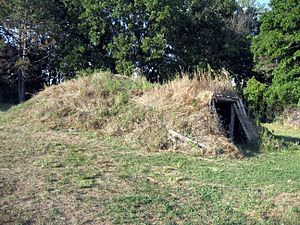
Glenwood people traded more with groups to the west than with the Mississippian cultures to the southeast. Around 1300 AD, both Mill Creek and Glenwood sites disappeared. They were replaced by the Oneota cultures.
Oneota (1250–1700 AD)
Very large Mississippian centers appeared around 1000 AD. These had huge earthen pyramids and strong walls. Cahokia, near St. Louis, was the earliest and largest. It controlled trade in the upper Mississippi.
In Iowa, there is little evidence of direct Mississippian control. After Cahokia declined around 1250 AD, local Late Woodland groups grew more complex. They formed large villages and their own trade network called Oneota.
Oneota sites are easy to spot by their round, shell-tempered pots. These pots often have handles and carved designs. They were good for cooking porridge and other cultivated foods. Important Oneota sites in Iowa include Kingston, Mckinney, and Blood Run. Oneota cultures spread across Iowa after Mill Creek and Glenwood disappeared. It is believed that the Oneota people were the ancestors of modern Native American tribes. These include the Ioway, Ho-Chunk, Otoe, Missouria, and Omaha.
Protohistoric Period (1600–1800 AD)
The Protohistoric period is when Native Americans first got European trade goods. Big population changes happened due to European diseases and wars. But there are few written records from this time. Explorers like Marquette and Joliet sometimes wrote about Native Americans in Iowa. But regular written accounts only became common in the early 1800s.
Native Americans in this period continued some Oneota traditions. But soon, almost all their own technology disappeared. This included making pottery and stone tools. During this time, the Meskwaki (Fox) and Sauk tribes arrived in eastern Iowa. They had been forced from their homes further east. Important sites include Milford and Blood Run.
Historical Period (1800–present)

The first European forts and trading posts were built in the 1680s. Few of these early sites have been found by archaeologists. Julien Dubuque’s Mines of Spain settlement was studied by archaeologists. Fort Madison (1808–1813) was Iowa's first American fort. It was partly dug up in 1965.
American settlers began arriving in the 1830s. Native Americans were officially moved out of Iowa by 1852. Several historical sites from this time have been excavated. These include Gilbert’s Trading Post and Fort Atkinson. Archaeologists also study historical American settlements. Examples include the Plum Grove Historic House and the Buxton African-American community.
See Also
- Native American history of Iowa
- Archaeological sites in Iowa
- Pre-Columbian cultural areas
- Pre-statehood history of Iowa
- Protected areas of Iowa
- Former Native American populated places in the United States
- Clovis sites
- Archaic period in North America
- Mound Builders
- Woodland period
- Mississippian culture


